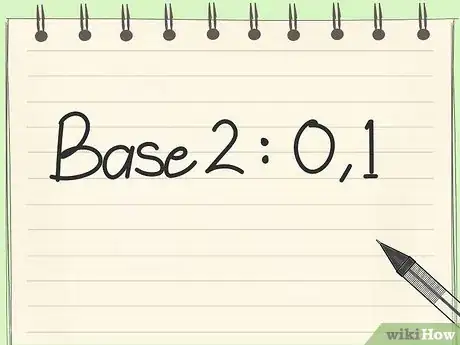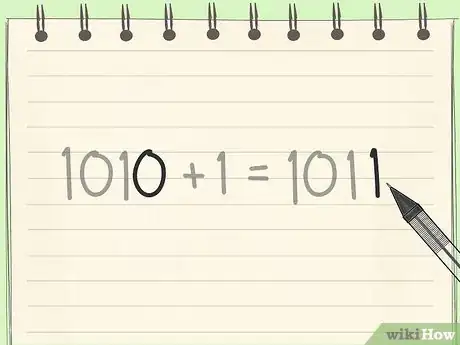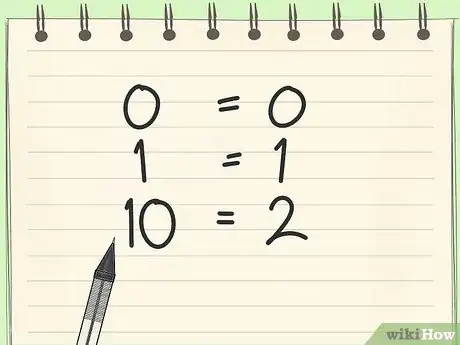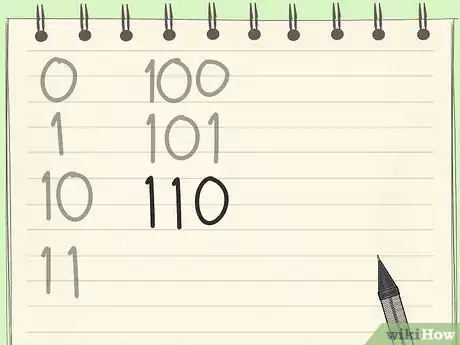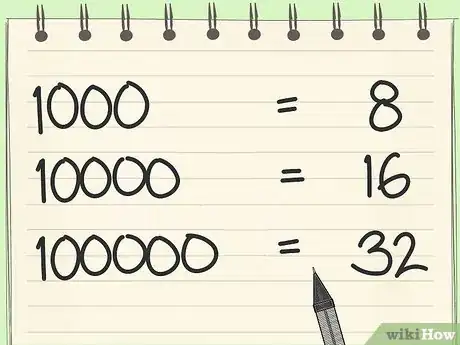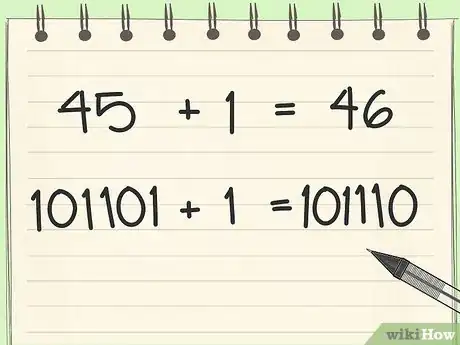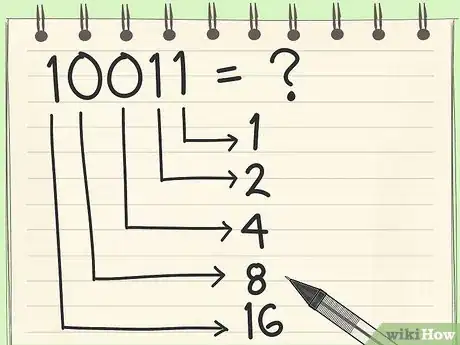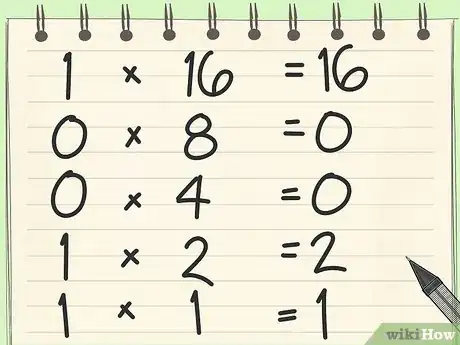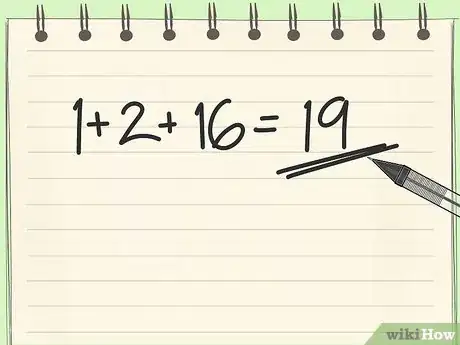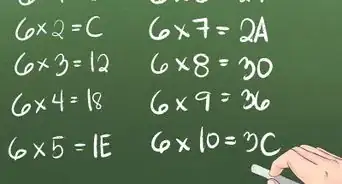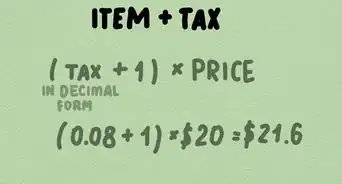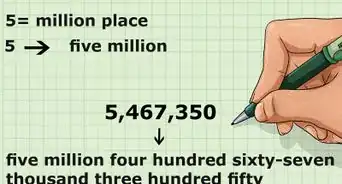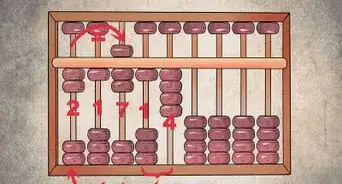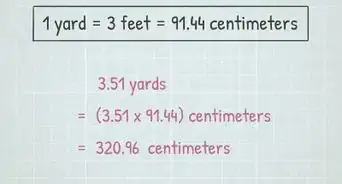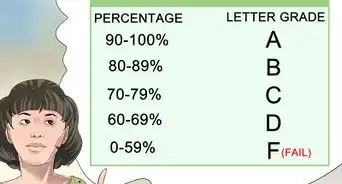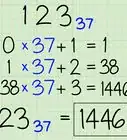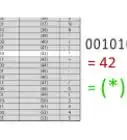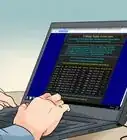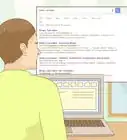This article was co-authored by wikiHow Staff. Our trained team of editors and researchers validate articles for accuracy and comprehensiveness. wikiHow's Content Management Team carefully monitors the work from our editorial staff to ensure that each article is backed by trusted research and meets our high quality standards.
There are 8 references cited in this article, which can be found at the bottom of the page.
wikiHow marks an article as reader-approved once it receives enough positive feedback. In this case, several readers have written to tell us that this article was helpful to them, earning it our reader-approved status.
This article has been viewed 231,233 times.
Learn more...
Want to improve your nerd skills? Learn the counting system computers use for all their calculations. It looks strange at first, but you only need a few rules and a little practice to count in bin ary.
Reference table
|
Decimal |
0 | 1 | 2 | 3 | 4 | 5 | 6 | 7 | 8 | 9 | 10 |
|
Binary |
0 | 1 | 10 | 11 | 100 | 101 | 110 | 111 | 1000 | 1001 | 1010 |
Steps
Learning Binary
-
1
-
2Add one by changing the last 0 into a 1. If a binary number ends in 0, you can count one higher by changing this to a 1. We can use this to count the first two numbers just as you would expect:
- 0 = zero
- 1 = one
- For higher numbers, you can ignore the earlier digits of the number. 1010 + 1 = 1011.
Advertisement -
3Write another digit if all the numbers are one. Now we have "1" for one, but we've already run out of symbols! In order to count to two, we need to write another digit. Add a "1" to the front of the number, and "reset" all the other digits to 0.[3]
- 0 = zero
- 1 = one
- 10 = two
- This is the same rule we use in decimal when we run out of symbols (9 + 1 = 10). It just happens a lot more often in binary because we run out of symbols sooner.
-
4Use these rules to count to five. These rules will get you as far as the number five. See if you can do it yourself, then check your work:[4]
- 0 = zero
- 1 = one
- 10 = two
- 11 = three
- 100 = four
- 101 = five
-
5Count to six. Now we need to solve five + one in decimal, or 101 + 1. The key here is to ignore the first digit. Just add the 1 + 1 at the end to get 10. (Remember, this is how you write "two".) Now restore the first digit and you get:[5]
- 110 = six
-
6Count to ten. There are no new rules you need to learn. Try it yourself, then check your work with this list:[6]
- 110 = six
- 111 = seven
- 1000 = eight
- 1001 = nine
- 1010 = ten
-
7Notice when new digits get added. Do you see that ten (1010) doesn't look like a "special" number in binary? Eight (1000) is much more important now, because it equals 2 x 2 x 2. Keep multiplying by two to find other important numbers like sixteen (10000) and thirty-two (100000).
-
8Practice with higher numbers. Now you know everything you need to count in binary. If you're ever confused about what comes next, just work out what happens to the last digits. Here are a few examples to help you out:[7]
- twelve plus one = 1100 + 1 = 1101 (0 + 1 = 1, and the other digits stay the same.)
- fifteen plus one = 1111 + 1 = 10000 = sixteen (We've run out of symbols, so we reset to 0 and write a 1 at the start.)
- forty-five plus one = 101101 + 1 = 101110 = forty-six (We know 01 + 1 = 10, and the other digits stay the same.)
Converting from Binary to Decimal
-
1Write down the value of each binary place. When you learned decimal counting, you learned about the "place values": the ones place, tens place, and so on.[8] Since binary has two symbols, the place values multiply by two each time you move to the left:
- 1 is the ones place
- 10 is the twos place
- 100 is the fours place
- 1000 is the eights place
-
2Multiply each digit by its place value. Start with the ones place on the far right, and multiply that digit (0 or 1) by one. On a separate line, move to the twos place, and multiply that digit by two. Repeat this pattern until you've multiplied each digit by its place value.[9] Here's an example:
- What is the binary number 10011 in decimal?
- The rightmost digit is 1. This is in the ones place, so multiply by one: 1 x 1 = 1.
- The next digit is also 1. Multiply this by two: 1 x 2 = 2.
- The next digit is 0. Multiply this by four: 0 x 4 = 0.
- The next digit is also 0. Multiply this by eight: 0 x 8 = 0.
- The leftmost digit is 1. Multiply this by sixteen (eight times two): 1 x 16 = 16.
-
3Add all the products together. Now you've converted each digit into its decimal value. To find the value of the full number, just add all the decimal values together. Here's the rest of your example:[10]
- 1 + 2 + 16 = 19.
- The binary number 10011 is the same as the decimal number 19.
Community Q&A
-
QuestionHow many bits would I need if I wanted to have the ability to count up to 1000?
 Jordan NewberryCommunity AnswerTen bits. 1000 in binary is: 11 1110 1000 -- log₂(1000)≈9.966 bits. Of course, we can't use 9.966 bits, so we round up to the nearest integer: 10 bits.
Jordan NewberryCommunity AnswerTen bits. 1000 in binary is: 11 1110 1000 -- log₂(1000)≈9.966 bits. Of course, we can't use 9.966 bits, so we round up to the nearest integer: 10 bits. -
QuestionCan you summarize this topic?
 DonaganTop AnswererIn binary notation, in the first column on the right (the "one" column), 0 means zero 1's, and 1 means one 1. In the next column to the left (the "two" column), 0 means zero 2's and 1 means one 2. In the next column (the "four" column), 0 means zero 4's, and 1 means one 4. The same pattern follows in each column. Moving to the left, the columns are "sixteen," "thirty-two," "sixty-four," and so on, each column being worth twice as much as the column to its right. For example, take the base-ten number 61: 61 consists of one 32 plus one 16 plus one 8 plus one 4 plus zero 2's plus one 1. So 61 is notated in binary as 111101 (pronounced "one one one one zero one").
DonaganTop AnswererIn binary notation, in the first column on the right (the "one" column), 0 means zero 1's, and 1 means one 1. In the next column to the left (the "two" column), 0 means zero 2's and 1 means one 2. In the next column (the "four" column), 0 means zero 4's, and 1 means one 4. The same pattern follows in each column. Moving to the left, the columns are "sixteen," "thirty-two," "sixty-four," and so on, each column being worth twice as much as the column to its right. For example, take the base-ten number 61: 61 consists of one 32 plus one 16 plus one 8 plus one 4 plus zero 2's plus one 1. So 61 is notated in binary as 111101 (pronounced "one one one one zero one"). -
QuestionHow do I convert 12 into binary?
 DonaganTop Answerer12 consists of one 8 plus one 4 plus zero 2's plus zero 1's, so the binary notation for 12 is 1100.
DonaganTop Answerer12 consists of one 8 plus one 4 plus zero 2's plus zero 1's, so the binary notation for 12 is 1100.
References
- ↑ https://www.computerhope.com/jargon/b/binary.htm
- ↑ https://www.mathsisfun.com/binary-number-system.html
- ↑ https://www.khanacademy.org/math/algebra-home/alg-intro-to-algebra/algebra-alternate-number-bases/v/number-systems-introduction
- ↑ https://www.mathsisfun.com/binary-number-system.html
- ↑ https://www.mathsisfun.com/binary-number-system.html
- ↑ https://www.mathsisfun.com/binary-number-system.html
- ↑ https://www.mathsisfun.com/binary-number-system.html
- ↑ https://www.mathwarehouse.com/non-decimal-bases/convert-binary-to-decimal.php
- ↑ https://www.electronics-tutorials.ws/binary/bin_2.html
About This Article
To count in binary, convert the last 0 in any number to 1 to add 1, and change any digits following the converted 1 back to 0. If all of the digits are already 1s, add a 1 to the beginning of the number and reset all of the other digits to 1. For instance, the number 1 is represented by 1, and the number 2 is written as 10. Following this, 3 is 11, 4 is 100, 5 is 101, 6 is 110, 7 is 111, 8 is 1000, and so on. To learn how to convert binary to decimal, read on!
